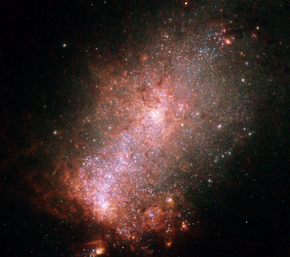| NGC 3125 | |
|---|---|
 | |
| Observation data (J2000 epoch) | |
| Constellation | Antlia |
| Right ascension | 10h 06m 33s |
| Declination | -29° 56’ 05” |
| Redshift | 0.003712 ± 0.000023 |
| Heliocentric radial velocity | 1113 ± 7 km/s |
| Apparent magnitude (B) | 13.45 |
| Surface brightness | 22.63 mag/arcsec2 |
| Characteristics | |
| Type | S;BCDG |
| Apparent size (V) | 1.1′ × 0.7′ |
| Other designations | |
| ESO 435-G041, AM 1004-294, MCG -05-24-022 | |
NGC 3125 is a large starburst galaxy in the constellation Antlia. It is located approximately 50 million light-years away from Earth. Starburst galaxies are galaxies in which unusually high numbers of new stars are forming, springing to life within intensely hot clouds of gas.
Morphology
NGC 3125 is notable as it displays large and violent bursts of star formation. Some of these stars are notable; one of the most extreme Wolf–Rayet star clusters in the local Universe, NGC 3125-A1, resides within NGC 3125.
Nearby galaxies
NGC 3125 is member of the LGG 189 Group, which also includes the galaxies NGC 3113, NGC 3137, and NGC 3175.
See also
References
- ^ "NASA/IPAC Extragalactic Database". Results for NGC 3125. Retrieved 2024-03-26.
- Now, Astronomy. "NGC 3125 – Astronomy Now". Retrieved 2024-04-19.
- "NGC 3125". science.nasa.gov. Retrieved 2024-04-19.
- Wofford, Aida; Leitherer, Claus; Chandar, Rupali; Bouret, Jean-Claude (2014-02-01). "A Rare Encounter with Very Massive Stars in NGC 3125-A1". The Astrophysical Journal. 781: 122. arXiv:1312.5982. doi:10.1088/0004-637X/781/2/122. ISSN 0004-637X.
- Garcia, A. M. (1 July 1993). "General study of group membership. II. Determination of nearby groups". Astronomy and Astrophysics Supplement Series. 100: 47–90. Bibcode:1993A&AS..100...47G. ISSN 0365-0138.
| Constellation of Antlia | |||||||||||
|---|---|---|---|---|---|---|---|---|---|---|---|
| Stars |
| ||||||||||
| |||||||||||
| Galaxies |
| ||||||||||
| |||||||||||